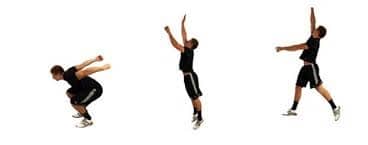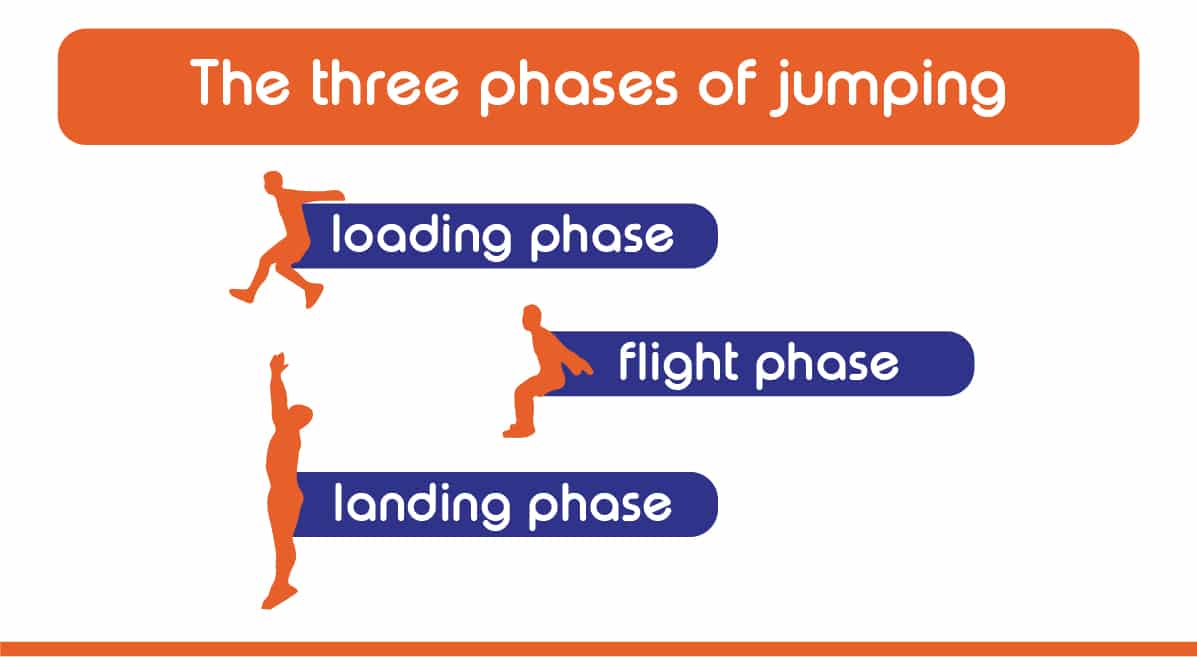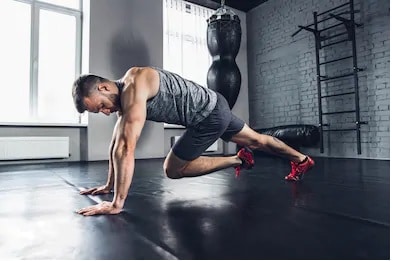
What Is A Vertical Jump?
The Vertical Jump is nothing more than the act of leaping into the air, after taking off from a horizontal plane.
The Vertical Jump is a series of exercises, which will adequately prepare your body to To Jump Higher in a competitive environment. These fall under the bracket of Vertical Jump Training.
It is also a series of tests that help measure your capacity to produce explosive power. The standard Vertical Jump Test can be the making and breaking of a career.
The Average Vertical Jump can also function as a means to provide much needed and sought after clarity on a person’s lower limb functionality, especially after injury and during rehabilitation.
Types Of Vertical Jump
When executing a Vertical Jump, you essentially have two options at your disposal. You could conceivably execute one from a Standing Position or after a brief Run-Up and Take-Off..
Which Sport Requires Vertical Jumping
1- Sports That Require A Standing Vertical Jump
Codes that mostly require an athlete who has mastered the art of the Standing Jump include but are not limited to: volleyball, diving, cheerleading, dancing, swimming and the martial arts.
2- Sports That Require A Running Vertical Jump
Codes that mostly require an athlete who has mastered the art of the Running Jump include but are not limited to: basketball, high jump, pole vault, hurdling, triple jump, long jump, gymnastics, ski jumping, figure skating and ultimate frisbee.
Why You Need To Develop Your Vertical Jump Skills
- Because you do not have a competitive standing reach.
- Because your body just isn’t able to produce the speed required to increase your Vertical Jump and Jump Higher.
- Because your body is unable to generate the explosive power required to produce a good vertical.
- Because your jump technique is absolute rubbish.
In the competitive environment, the finer margins matter a considerable amount. Sports scientists are constantly searching for methods that can help you improve your vertical jump skills.
Breaking Down The Proper Vertical Jump Technique

1- The Approach vs Countermovement Phase
The Approach, as we have labelled it, has primarily to do with the Running Jump. The Countermovement has primarily to do with the Standing Jump.
2- The Take-Off Phase
The take-Off happens when at least one of your lower limbs loses contact with the ground surface.
3- Flight or Airborne Phase
There are two aspects that matter most about your flight. The first is how long you stay airborne. The second is how high you eventually manage to go during the time when you are airborne.
4- The Landing Phase
Depending on the sport you are competing in, landing can be a complicated business. If you do not land well you could either hurt yourself or those you are competing against. Both eventualities hamper your jumping success.
Exercises To Increase Your Vertical Leap
1- Upper Body Vertical Jump Exercises

Unfortunately we are sticking to the obvious here, because frankly most upper body exercises will have to do with some element of weight training. It is hard to escape it.
- Close Grip Bench Press:
- The first port of call, before performing this drill will be to find somebody who can act as your spotter - somebody who is able to assess if and when he should intervene with your exercise routine.
- Then you need to find a flat bench that has been stationed together with a rack. The safest way to do any bench press is by lifting the barbell off this rack. There are other options available but we would strongly advise against them.
- Then you need to assess the right height from which to lift the barbell off the rack. Getting that wrong can have serious consequences for you, although the job of a spotter is ultimately to help avoid that type of injury in the first place.
- Conduct an assessment of what weight you are capable of lifting, before you start loading the barbell. If you are not sure or if this is your first time at the rodeo, the lower you go the better and you can gradually increase your weight from then onwards.
- Now that we are done with all of the admin, you can then lie on your back and prepare to lift the barbell off the rack. You will do this with a close grip, your hands closer together than normal.
- Once you have lifted the weight off the rack, bring it down slowly towards your chest. The safest way to go about this is to have your elbows as close to your body as possible for the duration of the routine.
- You will then push that weight back up slowly. That constitutes one repetition.
- Medicine Ball Slam:
- The point of departure here is to work up a little emotion. Get yourself nice and angry because the intensity with which you perform this drill matters. Otherwise it becomes nothing more than a strange little dance.
- Then find a medicine ball that you can take your anger out on. If you want to be sports specific, there is nothing stopping you from sourcing a basketball or even a netball. Part of the idea is to have a ball big enough that it demands you hold it with both hands.
- By the way, it is also refreshing to note that this is a plyometrics routine that helps strengthen the upper body.
- You should then start performing the drill from a standing position, feet about shoulder-width apart should just about do it.
- The ball, whatever its incarnation, should already be in your hands at this point. Hold it up just in front of your torso.
- Then in one fluid motion, rise to the balls of your feet and lift the bigger ball above your head. When the body is fully extended, you can then unleash your power in a downward direction, slamming the ball into the ground. If you are a basketball player you could think of this as a dunk with two hands.
- Dumbbell Row:
- Ordinarily, this routine would be performed with a bench and one dumbbell at a time. However, we have already covered that version elsewhere on these pages but it is worth noting that the core (pun intended) principles will remain the same.
- So, no bench huh? That means you will start this drill from a standing position, with a dumbbell in each hand.
- In the absence of a bench you will also have to support your own body weight when you flex your torso forward, until you are almost at a 90 degree position.
- When you are ready to start, the dumbbells should be about halfway down your shins. You will then pull both weights up until you reach your hips and then lower those limbs again until you are about a quarter way down your shins. That would constitute one repetition.
- Do not alter your body’s form at any point while still executing the drill.
2- Lower Body Vertical Jump Exercises

We have opted to go with the staple Plyometrics options here. That is primarily because they are so effective when it comes to jump training. However, it is also because they require the least admin to perform. You don’t need fancy equipment and your body weight is usually more than sufficient to help realize some of your vertical jump goals.
- Squat Thruster:
- This drill is strikingly similar to burpees. Strangely enough it can look like a cheat version of burpees but meanwhile it can also be a tricky drill to perform well consistently. It can be physically demanding and requires coordination.
- Start the drill in a plank position but carry yourself a little higher than you ordinarily would for the plank itself.
- Then bring your knees up towards your chest until you find yourself in a wide squat position. The latter means that your hands will need to leave the floor at the same time.
- Once you are up in that squat position, lower yourself back down into the original high plank position and repeat the routine.
- The key with this drill is speed. As is the case with the burpee, the greater the intensity with which you perform this drill, the more likely you are to achieve the desired results.
- Butt Kickers:
- Sadly, we have to report that Chuck Norris and Sylvester Stallone will not feature in this exercise, which takes place on a slightly larger trampoline normally suitable for the garden.
- You will also start this routine in a standing position.
- Then, out of the blue, you should bend your knee backwards and try to touch your buttocks with the heel.
- As a slight progression from this, you can kick back both feet at the same time.
- Reverse Lunge:
- You should start this drill in a standing position.
- Then you step backwards with your right leg, into a lunge position, as if to load the muscle groups in your legs.
- With the glutes adequately loaded in your left leg, you should then push yourself back upwards, while dragging the right leg with you.
- While you are exploding off the ground with your left leg, you should also pull your right knee up to about chest height, before repeating the routine again.
- The convention would be to perform this drill on the one side and then change sides after a series of repetitions.
Troubleshooting Your Vertical Jump - Why Are You Still Struggling With Height?
Most of your Vertical Jump problems will likely be determined by how you train. If you are having difficulty recording better heights there is the distinct possibility that there is some form of imbalance in your training regimen.
1- We always recommend starting off with lighter weights and fewer sets and even then only moving up gradually.
2- When training to jump higher, try as often as possible to assimilate the match environment.
3- Variety is important when training to jump higher, which is why we have posts on these pages that include as many as 12 exercises. They aren’t all great. In fact, just writing about some of them was brain numbing.
However, it is also important that some of those additional options are there because it is so easy to become jaded when training to jump higher. The problem with being jaded is that it can lower the intensity of your workout. It can also limit the focus required for your technique.
4- Not focusing enough on jumping in your training is one thing. However, things can get worse if not enough emphasis is placed on generating speed during your training. This is particularly relevant for the running jump, where speed matters so much when trying to generate some explosive power. It is also so easy to lose focus on that, partly because speed training can be incredibly mundane. This is where a certain degree of mental fortitude is required. Break through that mental wall!
5- Another one which often slips through the cracks is training that focuses more on coordination and quick reaction. So many of these exercises can be complicated affairs and too daunting for somebody giving it a good go for the first time. Do not be put off by the complexity of training regimens that require a considerable amount of coordination. That can be the difference between jumping well and failing to jump well.
The Final Verdict
Two of the major sporting bodies in the United States (that is basically code for the Entire World) conduct Vertical Jump Tests to determine if aspiring professional athletes are up to the mark.
The draft system - actually something quite unique to the United States - is implemented by both the NBA and the NFL.
For both American Football and Basketball, the draft is an annual event which essentially sorts the “wheat from the tares”, before professional teams make a commitment to signing up a young talent for the coming seasons.
Sports drafts are a complicated business in that teams don’t necessarily get to choose the players that they want. Because the selection process is conducted on a level playing field, administrators sometimes have to make do with the “best of the rest”. There is no way of knowing the best of the rest, if you do not conduct a series of comprehensive tests that help crystalize your judgement.
Testing an athlete’s jump quality is one of those determining factors. As we mentioned in our introduction, it is the kind of detail that can make or break a sportsman’s career - regardless of how talented you might be in other facets of the game.
Hey, I’m Aleksandar and I am a Basketball freak! That is why I decided to create this blog. Teaching people How to dunk a basketball and How to Jump Higher in this sport or other related sports that require vertical jumping, is my specialty. If that’s your aim, then you have come to the right place.
